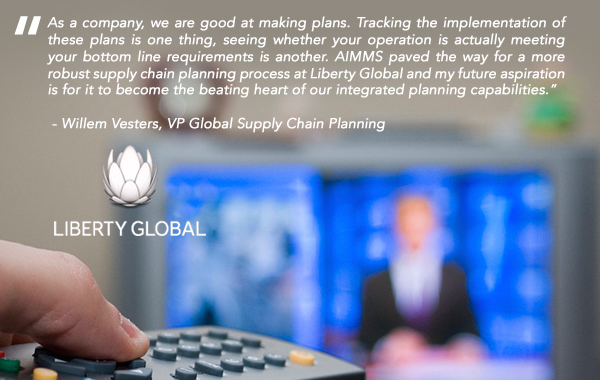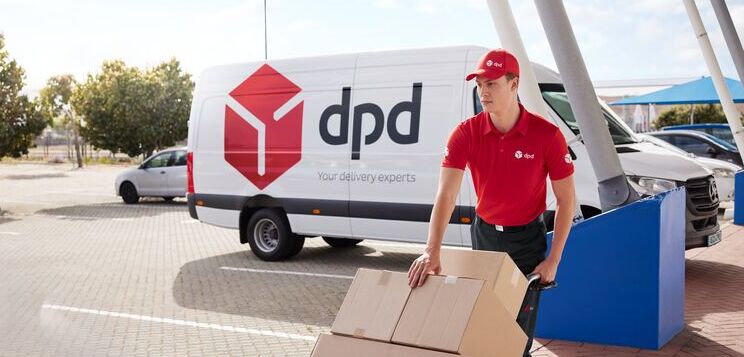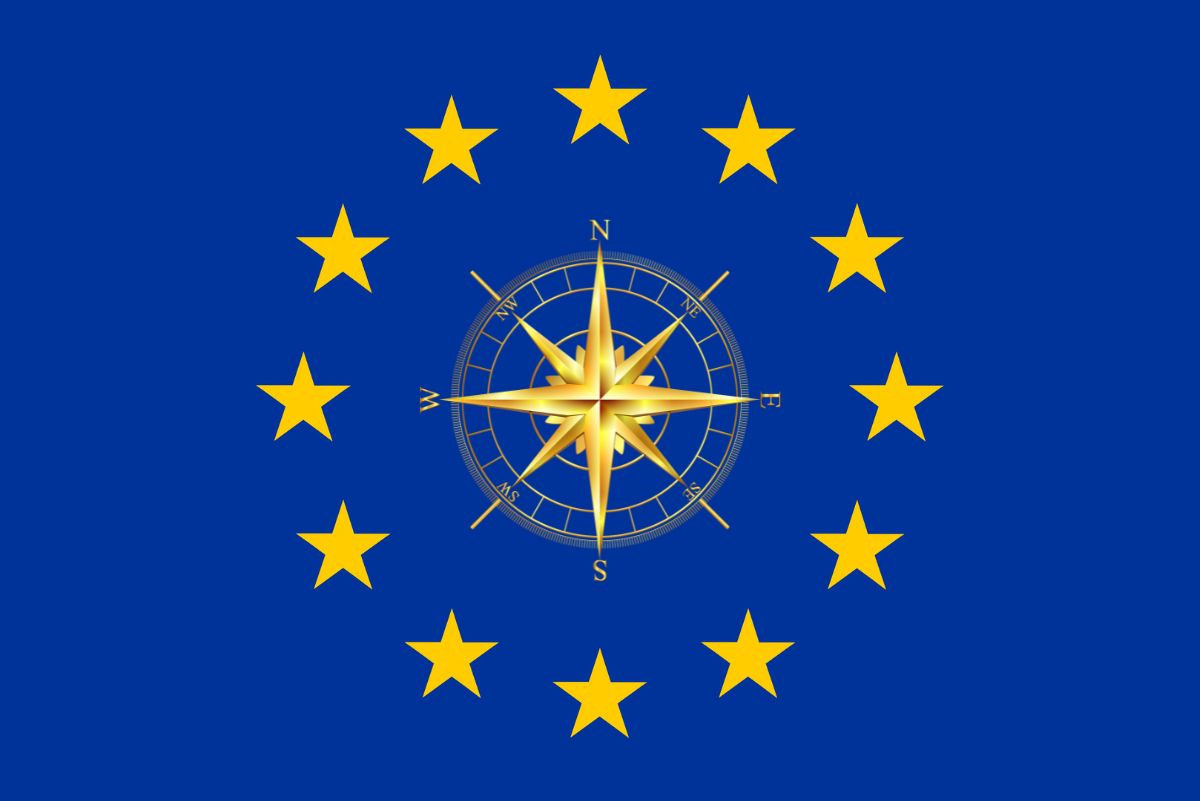 Liberty Global is the world’s largest international TV and broadband company with operations in more than 30 countries. The company started working with AIMMS and our implementation partner Districon in October 2015 to develop a Demand Aggregation tool. Today, they are looking to expand their use of AIMMS for other planning capabilities. We had the pleasure to speak with Willem Vesters, Liberty Global’s VP Global Supply Chain Planning, to learn more about their optimization journey.
Liberty Global is the world’s largest international TV and broadband company with operations in more than 30 countries. The company started working with AIMMS and our implementation partner Districon in October 2015 to develop a Demand Aggregation tool. Today, they are looking to expand their use of AIMMS for other planning capabilities. We had the pleasure to speak with Willem Vesters, Liberty Global’s VP Global Supply Chain Planning, to learn more about their optimization journey.
Hi Willem, can you please tell us more about your background?
I am originally from Breda, a city in the southern part of the Netherlands. I have a Master’s Degree in Aerospace Engineering from Delft University of Technology but I’ve spent most of my career in operations. I worked at ING for a short period, then moved to Philips, and subsequently I became the Supply Chain Planning Director for Office Depot in Europe. These days, I head up the Supply Chain Planning division at Liberty Global.
How did you hear about AIMMS?
I first heard about AIMMS at the Supply Chain Logistics Summit in Barcelona in 2015. At the time, I was setting up a Network Planning team and I was looking for the right supporting technology to build this capability. In October of that same year, we sat down together (AIMMS, Districon, and the right stakeholders within our company) to find out what we would need to take this further.
What kind of problem were you trying to solve?
We have a fairly robust supply chain planning process for managing and installing Customer Premises Equipment (CPE). These are all the setup boxes we use in the customer’s house, cable boxes and modems for example. However, our Network Materials supply chain lacked an advanced planning process and capability. Network Materials ensure that those devices at the end customer are connected to the world wide web and it’s an infrastructure located both in and above the ground.
So we were struggling with the fact that we had a part of our business under control, but another one that was almost completely out of our grip. Visibility into the Network side of the business was limited to the company’s engineering and procurement department. These 2 worlds are dependent on each other, so we needed to connect them. That way, we could start answering questions like:
- What we are allowing ourselves to invest in network expansion with a proper payback time?
- How do we create a view to calculate and optimize a return out of that expanded customer base?
- How do we get the insights needed to start optimizing toward cash, revenue, or capital investment?
We needed to be able to connect the dots here to get a more accurate forecast, especially since we were also expanding our network through acquisitions. These are the key questions we wanted to answer by using AIMMS.
How did you do things differently at Liberty Global before starting your AIMMS project?
Our engineers designed our network infrastructure and those designs resulted in a list of requirements and materials. Then, we would start building based on the delivery schedule of our vendors. Some vendors were able to deliver quickly, but others could not. As a result, we would start a build when we had all the materials together. This was a fairly inefficient way of building and structuring. Our inventory levels on this side of the business tend to be quite high, with a rotation going to 1 year. So this is where we were and we recognized that this could be done better.
“This is step 1. If you’re still in denial as a company, you can’t improve.”
After this, we realized that we needed to build a team and we needed to support them with the right technology. That’s when we decided to work with AIMMS and Districon to build a tool that would help us build a better demand forecast. We are now 9-months into the process of improving our forecast levels and consolidating our demand plans and are now at a point where we can start optimizing.
Why was this the right moment to start using advanced analytics?
That’s a good question. I guess on the CPE side of the business, we proved that we could bring down inventory levels and generate value. We limited the amount of cash we needed for inventory by bringing it down by 35%. We had massive stock outs before and by developing a supply plan that was shared and committed to by vendors, we were able to align demand uplifts more closely and mitigate delivery issues. So we had a proven case for improvement. In addition, there was an urgency because we are going after a very aggressive expansion plan in our network infrastructure. We plan to expand our footprint by roughly 25% in the coming years and for this operational growth, we need operational traction and grip.
The timing was perfect. The business need and track record were there.
How did your project gain the momentum necessary to be adopted internally?
The momentum came when we saw the prototype coming together during a 2-day Proof of Concept workshop hosted by AIMMS.
What did this POC Workshop look like?
From a stakeholder perspective AIMMS provided the technology, Districon provided experienced consultants who could turn our requirements into an automated process, and we brought our country representatives to the table. We brought end users from the UK, Belgium, Switzerland, and so on. That gave us a critical mass that could be representative of the company.
It was an international project from the start. It wasn’t a project initiated in an ivory tower. It was co-created by users who would use the tool in their respective countries. This helped us get a buy-in agreement. We had the right setting and people together to drive this quite quickly during this 2-day workshop.
We had a very high-level discussion about our needs and Districon started constructing a model on the fly.
“We had a rapid prototype built over night that we could review the next day.”
Are there any other solutions that you considered?
Yes. At this point, we are not taking full advantage of the AIMMS platform at Liberty Global. The POC was a way to introduce the technology in our organization. At the same time, we are developing an off-the-shelf-based planning and replenishment solution for all our materials. What we see is that off-the-shelf technology is very good for replenishment, basic planning, and so on. But AIMMS can play a much stronger role in optimization. With AIMMS, we start engaging in the next level of optimization and integrated planning. From the process support angle, AIMMS also outperforms.
“Moreover, we can calculate scenarios based on a long-range plan 2-3 years out. That is something we will never be able to depict in off-the-shelf tools. The level of customization and various optimization angles are not covered by off-the-shelf technologies or an ERP. This is where the true strength of AIMMS will start to come to life. AIMMS will feed our executive decisions, not only our monthly operational decisions.”
Besides this, 3 things helped while choosing between AIMMS and other vendors:
- The price entry point
- The speed to develop the first practical outcome
- The fact that you can get basic insights delivered quickly
 How does your team at Liberty Global use AIMMS in their daily work?
How does your team at Liberty Global use AIMMS in their daily work?
At the moment, 2 people in our Amsterdam office and 8-9 people in the field use the AIMMS app. We mimicked our planning process in the tool and we still need people to build AIMMS Apps internally.
“We’re trying to tap into AIMMS’ full potential and for that, we want to develop AIMMS Apps ourselves.”
Can you share some results that you’ve seen since the Demand Aggregation app was rolled out?
We have 70% planning accuracy now for the scope of materials. Before, our planning accuracy was nonexistent. This has allowed us to present a more accurate demand forecast to our key vendors.
As a second-level result, we now have a much better value-based conversation about investment and budget control. We can focus more on opportunities and can quantify the results of an accurate demand forecast on a bottom-line impact level.
What are your plans for the future?
AIMMS should become business as usual for how we plan. My future aspiration is for AIMMS to become the beating heart of Liberty Global’s integrated planning capabilities.





